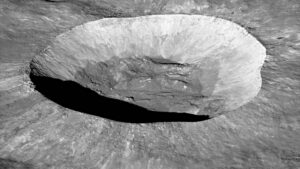Blood Falls, Antarctica is a rare natural wonder that few people will ever lay eyes on. Scientists from around the world come here to learn more about life elsewhere in the universe.
Do you remember that iconic river of blood scene from The Shining? Moviegoers were spooked by that terrifying spectacle but went home from the theatre knowing that it was all filmmaking magic and, above all, fictional. But is it really? In Antarctica, a blood-red waterfall is very real indeed.
Why is Blood Falls Red?
Pouring out from the Taylor Glacier and into Lake Bonney is one of the rarest sights in the world; a waterfall of “blood” that flows onto the immaculate ice, staining it with a startling blood-red color. Why this spectacular natural oddity exists has puzzled scientists for decades until a recent study put their curiosity to rest.

A scientist examines Blood Falls. Photo: Benjamin Urmston via ScienceNow
This macabre-looking deposit was discovered in 1911 by Griffith Taylor (after whom the glacier was named), an Australian geologist and survivor of the ill-fated Terra Nova Expedition. Taylor and his team hypothesized that red algae were responsible for the water’s color. However, this was later disputed. It turns out to be a result of a complex chemical reaction that has taken place over 1.5 million years as the water traveled through the glacier’s endless network of fissures and passages.
Scientists often refer to this water as a “liquid time capsule.” After being sealed in the glacier with no sunlight or oxygen at high pressure for so long, the brine saltwater turns blood red upon contact with the open air. The high concentration of iron in the water creates this iconic, otherworldly display.
Taylor Glacier’s Unique Makeup
It was initially believed that the glacier was completely solid from top to bottom. Scientists made the groundbreaking discovery using radio-echoing technology and an IceMole, finding hypersaline rivers (three times as salty as seawater) and reservoirs 400 metres below the glacier which were able to retain their liquid form. This oddity is a result of the creation of an inland saline lake that formed five million years ago when East Antarctica was flooded. Millions of years later, a glacier formed over the lake as sea levels rose, thereby trapping the lake beneath it.

The Blood Falls location at the Taylor Glacier. Photo from Wikipedia
How was it able to withstand the freezing temperatures? There are several reasons for this phenomenon. As the water freezes, small amounts of heat are released. Together with the water’s hypersaline nature, the water freezes at a lower temperature than fresh water does and also contains microbes that survive in this harsh and high-pressure environment, feeding off of the water’s sulfates by metabolizing its sulfate and ferric ions. This has never been seen in the natural world before.

Photo: Reddit
Blood Falls and Outer Space Research
These revelations have made Blood Falls a popular site for astrobiology research. Who would have thought that this remote corner of the world could possibly hold the answers as to whether or not other planets and moons are capable of life? A study conducted by the University of Tennessee showed a total of 17 types of microbes thriving in the glacier, all of which provide meaningful data into Earth’s conditions 700 million years ago and the suitability of Mars, Europa, and Titan for human life. These potential candidates are believed to possess similar hypersaline oceans and rivers.
Blood Falls, this natural earthly wonder is, all in all, another key to unlocking more of our universe.

Astrobiologists come to investigate Blood Falls. Photo: Reddit






